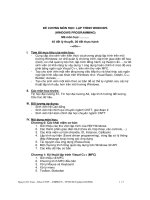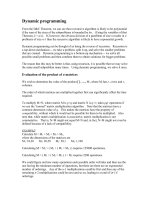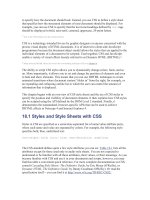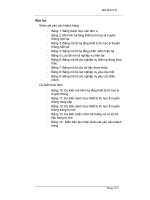01 info sheet
Bạn đang xem bản rút gọn của tài liệu. Xem và tải ngay bản đầy đủ của tài liệu tại đây (103.73 KB, 2 trang )
CS224W: Analysis of Networks
Fall 2018
CS224W: Course Information
Instructor Jure Leskovec
Office Hours: Tuesdays 9:00-10:00AM, Gates 418
Co-Instructor Michele Catasta
Office Hours: Thursdays 5:00-7:00PM, Gates 452
Lectures 3:00PM-4:20PM Tuesday and Thursday in NVIDIA Auditorium, Huang Engineering Center
Course website
Contact
• For course related questions, use Piazza: />(use access code “snap” to register)
• For other requests, e-mail us at
• SCPD students can attend office hours remotely via a Google Hangout; the link will be posted
on Piazza just before the office hours start.
TAs (check the website for times and locations of the office hours)
•
•
•
•
•
•
•
Michele Catasta (pirroh) [head TA]
Alex Haigh (haighal)
Alexander Wang (aswang96)
Javier Sagastuy Brena (jvrsgsty)
Jayadev Bhaskaran (jayadev)
Megha Jhunjhunwala (meghaj)
Shuyang Shi (bsnsk)
Topics
•
•
•
•
•
•
•
•
•
•
Six degrees of separation
Models of the small world
Network Inference
Network Robustness
Power-laws and Preferential attachment
Models of network evolution
Cascading behavior in networks
Models of network cascades
Influence maximization in networks
Knowledge Graphs and Metapaths
• Finding communities and clusters in networks
• Spectral clustering and large scale community
structure in networks
• Modularity and large scale community structure in networks
• Message passing and Node classification
• Network motifs, Structural roles in networks
• Link analysis, Pagerank
• Node Representation Learning, Node2Vec
• Graph Convolutional Networks
Course Grading
•
•
•
•
1 setup assignment (1%) + 3 (9.6% each) homework requiring coding and theory (30%)
2 hour open-book exam (30%)
Final project: proposal, milestone report, poster presentation, and final report (40%)
Piazza and course participation, contributions to the SNAP codebase (extra credit factored in during
grading)
CS224W: Analysis of Networks,
2
Assignment Policy
Questions We try very hard to make questions unambiguous, but some ambiguities may remain. Ask (i.e.,
post a question on Piazza) if confused or state your assumptions explicitly. Reasonable assumptions
will be accepted in case of ambiguous questions.
Honor Code We strongly encourage students to form study groups. Students may discuss and work on
homework problems in groups. However, each student must write down the solutions independently.
That is, each student must understand the solution well enough in order to reconstruct it by him/herself.
In addition, each student should write down the set of people whom s/he collaborated with.
Late Submissions Each student will have a total of 2 late periods to use for homework. Homework are
due on Thursdays and late periods extend to midnight (11:59PM) on the following Monday. Only one
late period can be used per assignment, and no assignment will be accepted more than one late period
after its due date (modulo a 15min grace period). Late periods can also be used for the submissions
related to the final project (i.e., proposal and milestone) except the final writeup.
Assignment Submission All students (SCPD and non-SCPD) submit their homework via Gradescope
(, entry code 9ZZ2XY). Students can typeset or scan their homework.
Make sure that you answer each question on a separate page. That is, one answer per page regardless
of the answer length. To register for Gradescope, please use your Stanford email (if non-SCPD) and
Stanford ID number. Students also need to upload their code at />Put all the code for a single question into a single file and upload it.
Prerequisites
Students are expected to have the following background (recitation sessions will refresh these topics):
• Knowledge of basic computer science principles, sufficient to write a non-trivial computer program
(e.g., CS107 or CS145 or equivalent are recommended.)
• Familiarity with the basics of probability theory (CS109 or Stat116 are sufficient but not necessary.)
• Familiarity with the basics of linear algebra (any one of Math 51, Math 103, Math 113, or CS 205
would be much more than necessary.)
Materials
Notes and reading assignments will be posted on the course website. Selected readings for the class will be
from: Networks, Crowds, and Markets: Reasoning About a Highly Connected World by D. Easley and J.
Kleinberg (PDFs available online).
Important Dates
Assignment
Homework 0
Homework 1
Project proposal
Homework 2
Project milestone
Homework 3
Exam
Project final report
Project poster session
Out
now
September 27
October 11
October 25
Due
October 4
October 11
October 18
October 25
November 8
November 15
November 29
December 9 (no late periods)
December 11, 3:30-6:30PM
We will also hold 2 review sessions (which will be recorded) in the first two weeks of the course:
• SNAP.PY, scalable network analysis in Python: Gates B01, Friday 09/28, 2:30 - 3:20 PM
• Review of probability, linear algebra, and proof techniques: Gates B01, Friday 10/5, 2:30 - 3:20 PM









